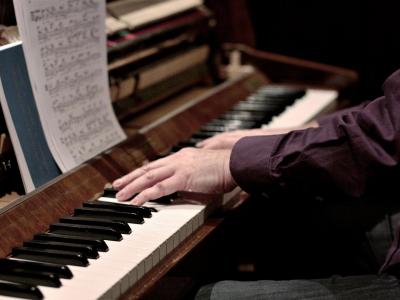12 Weeks
Level 1
3-Credit Tuition
$1,245Non-Credit Tuition
$1,090Master the basics of Keyboard technique and chord voicings, and gain an understanding of more advanced concepts including blues progressions and playing three part chords in this 12-week course. Through exercises that explore the interpretation of lead sheets and chord symbols, the Berklee Keyboard Method will help you to improve your performance, harmonic vocabulary, and composition/arranging skills. By the end of the course you will be able to improvise over a lead sheet while comping chords with their appropriate voicings.
By the end of this course, you will:
- Understand how to read treble clef, bass clef and play simple melodies on the grand staff
- Understand accidentals and play the black keys on the keyboard
- Increase your ability to read and play different notes simultaneously
- Understand and play melodies with major and minor triads in right hand
- Understand voice leading triads
- Understand a lead sheet and play chords and bass with left hand
- Add three-part chords to your playing
- Understand altered 9ths, 13ths and Blues progressions
Syllabus
Lesson 1: Treble Clef
- Treble clef notes related to keyboard
- Right hand keyboard fingering numbers
- Moving 5-note one hand position to various locations within treble clef
- Playing a simple treble clef notated melody with right hand
Lesson 2: Bass Clef
- Bass clef notes related to keyboard
- Left hand keyboard fingering numbers
- Moving 5-note one hand position to various locations within bass clef
- Playing a simple bass clef melody with the left hand
Lesson 3: Grand Staff
- Grand staff notes related to keyboard
- Moving both hands to various 5-note positions on the grand staff
- Playing simple one line melodies with both hands in octaves
- Playing simple one line melodies switching hands and clefs
Lesson 4: The Black Keys/Accidentals
- The black keys of the keyboard - their significance and location
- Moving hand positions around which include accidentals creating major/minor tonalities
- Playing simple one line melodies in octaves which include accidentals
- Playing simple one line melodies switching clefs which include accidentals
Lesson 5: Independence Between Hands
- Studies to Increase the Ability to Read and Play Different Notes Simultaneously
- Rhythmic Independence Studies
- Playing Two Notes Simultaneously in One or Both Hands
Lesson 6: Major and Minor Triads
- Major and Minor Triads in Root Position
- Inversions of Major and Minor Triads
- Melodies with Major and Minor Triads in the Right Hand
Lesson 7: Voice Leading Triads
- Diatonic Triads
- Voice-Leading the I IV V Progression
- The I VI II V I Diatonic Progression
- Voice Leading the I VI II V I Progression
Lesson 8: Left-Hand Chord Playing
- Voice Leading Left-Hand Chords
- The Lead Sheet
- The Left Hand as Both Chords and Bass
Lesson 9: Right-Hand Chord Playing
- Voice Leading Right-Hand Chords
- "Slash Chords"
- Arpeggiating Right-Hand Chords
Lesson 10: IIm7 V7 Imaj7 Left-Hand Shells
- The IIm7 V7 Imaj7 Progression
- Left-Hand Shells
- Using Left-Hand Shells to Support Right Hand Activity
Lesson 11: Using the 3rd and 7th of the IIm7, V7, Imaj7
- Finding and Voice Leading the 3rd and 7th
- Using the 3rd and 7th in the Right Hand with Left- Hand Bass
- Using the 3rd and 7th to Support Melody
Lesson 12: Three-Part Chords
- Adding the 9th and 13th to the Dominant 7th
- Adding sus 4 to the Dominant 7th
- Comping Patterns Using Three-Part Chords
Requirements
Prerequisites and Course-Specific Requirements
Prerequisite Courses, Knowledge, and/or Skills
At least one year of experience on a musical instrument is required.
Knowledge of basic pitch notation:
- Letter names of notes
- Some reading ability with one clef
- Bar lines, measures, double bar lines, fine bar lines, repeats
- Sharps, flats, naturals
- Key signatures
- Phrase markings
- Few ledger lines
Knowledge of basic rhythm notation: - Note and rest values up to eighths
- Their value in common meters like 4/4; 3/4
- Dotted note values, ties
- Some ability to read these rhythms
Knowledge of basic harmony: - Basic level of diatonic concepts (helpful but not absolutely necessary)
- Major and minor scales
- Seventh chords and chord construction, inversion
Textbook(s)
- No textbooks required
Recording
- Students are required to record video while playing along with a backing track for their assignments. Options for recording video include:
- Smartphone
- Digital camera
- External webcam
- Note: The camera view must be from above, recording the keys right side up. It is imperative that the videos show the student's fingerings. You may need certain accessories to accomplish this, such as a goose-neck camera holder, tripod, etc.
Instrument
- Piano or keyboard instrument with at least 61 keys and a sustain pedal
- If using a MIDI keyboard controller, a high-quality piano software instrument is also required.
- If using a digital piano or keyboard workstation without built in speakers, an audio interface or amplifier is also required.
Hardware
- Students are required to capture their instrumental performance, as well as monitor audio output. Options include:
- Input (one required if not using MIDI and software instruments):
- Keyboard connected directly to audio interface (recommended non-acoustic option; alternatively, the microphone options below can be used with amplified instruments)
- XLR microphone and audio interface (recommended acoustic piano option)
- USB microphone
- Built-in computer/mobile device microphone
- Output (one required):
- Headphones (recommended option; required if multitracking and/or input monitoring a microphone)
- Studio monitors and audio interface
- Built-in or external computer speakers
- Input (one required if not using MIDI and software instruments):
- Note: Depending on your setup, you may also need XLR/instrument cables and microphone stand(s).
Student Deals
After enrolling, be sure to check out our Student Deals page for various offers on software, hardware, and more. Please contact support@online.berklee.edu with any questions.
General Course Requirements
Below are the minimum requirements to access the course environment and participate in Live Chats. Please make sure to also check the Prerequisites and Course-Specific Requirements section above, and ensure your computer meets or exceeds the minimum system requirements for all software needed for your course.
Mac Users
PC Users
All Users
- Latest version of Google Chrome
- Zoom meeting software
- Webcam
- Speakers or headphones
- External or internal microphone
- Broadband Internet connection
Instructors
Author
Paul Schmeling (1938-2024) was a master pianist, interpreter, improviser and arranger who inspired countless students since he began teaching at Berklee in 1961. He has performed or recorded with jazz greats such as Clark Terry, Rebecca Parris, George Coleman, Carol Sloane, Frank Foster, Art Farmer, Herb Pomeroy, Phil Wilson, Dick Johnson and Slide Hampton. In the 1990s, the Paul Schmeling Trio released two inventive and critically acclaimed albums, interpreting the music of Hoagy Carmichael and songs associated with Frank Sinatra. He was chair of the piano department for 40 years, and he co-authored the Berklee Practice Method: Keyboard (2001) and Instant Keyboard (2002) and on his own he wrote Berklee Music Theory: Book 1.
Instructor
James Ross Ramsay, faculty in the Piano department at Berklee College of Music, has been teaching piano for 25 years, and has been included in the "Who's Who List of American Teachers" several times. He composes and produces music for local and nationally broadcast television, radio, cable, and video programs, and has been a featured soloist on piano and keyboards with various artists touring throughout the United States and Europe. Ramsay is a product specialist and clinician for Yamaha Corporation of America, Digital Musical Instruments, and Pro Audio Division. He received a Bachelor of Music from Berklee College of Music in 1986.
Instructor
Suzanna Sifter is a jazz pianist, author, and educator who has been on faculty at Berklee College of Music for 30 years. She holds a BM from Berklee and Master’s Degree from New England Conservatory.
Suzanna has traveled extensively with Berklee to places such as Europe, South America, the US, Canada and Japan giving master classes and performing. Suzanna has five recordings as a leader, composer, and arranger: Flowers for You, Awakening, The Illumination, Sophisticated Lady, and the play along CD to her book, Berklee Jazz Keyboard Harmony: Using Upper Structure Triads. The second edition of Suzanna's book was released through Hal Leonard/Berklee Press in May 2015.
Suzanna has performed with John La Porta,, Alan Dawson, John Lockwood, Yoron Israel, Dave Clark, and recorded with Casey Scheuerell, Jon Hazilla, Bruce Gertz, Dino Govoni, Tony Lada, Larry Monroe, and Greg Badolato. Her compositions have been featured on “In the Library” (D. Govoni) and “On the Edge” (T. Lada).
Suzanna's fifth recording, Sophisticated Lady, is a musical tribute to her late mother and was released in July 2018. It features luminous solo jazz piano with relaxing yet poignant improvisations and arrangements. Read Less
Instructor
Ever since she began publicly performing in Korea at the age of nine, pianist and composer, Hey Rim Jeon, has outstanding musical talents that have led to significant recognition in the international jazz community. Described as a “brilliant pianist” bylegendary saxophonist Benny Golson, Ms. Jeon has been featured on NBC’s “Weekend Today in New York”, and KBN, Korea’s National TV network channel. As a leader of her own band, Hey Rim Jeon & Friends, she has performed both nationally and internationally. Her album, “Mona Lisa Puzzle”, has been described as an “intense, intelligent statement…” by Bill Milkowski of Jazz Times, won the Best Jazz Album category in the 2009 New England Urban Music Awards, and reached CD Baby’s Top 10 Modern Creative Jazz Albums list. As a recipient of Berklee’s
prestigious Mentorship Award in 2021, Ms. Jeon has been serving as an Associate Professor in the Piano Department at Berklee College of Music since 2010.
What's Next?
When taken for credit, Berklee Keyboard Method can be applied towards the completion of these related programs:
Related Certificate Programs
Related Degree Majors
Questions?
Contact our Academic Advisors by phone at 1-866-BERKLEE (U.S.), 1-617-747-2146 (INT'L), or by email at advisors@online.berklee.edu.































